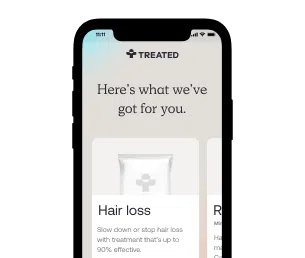Verrucas
Treatments for smooth, healthy feet.
Secure delivery
UK clinicians
Verrucas are small, rough, fleshy growths on the feet. They’re caused by a virus and can sometimes be painful or uncomfortable. Mostly they’re just a bit unsightly and don’t cause any problems.
We deliver straight to you when you order verruca treatment online with us. Our team of clinicians are also on hand to give you tailored aftercare.
Verrucas are technically a type of wart called plantar or palmar warts. Like other warts, they’re caused by the HPV virus infecting the skin. But verrucas only appear on the feet.
Verrucas are often more likely to be painful than other types of warts, and they can make walking difficult. You can also spread them to others through skin to skin contact or contaminated surfaces. So it’s good to treat your verrucas if you can.
Verrucas can affect anyone, but babies and very young children are less likely to develop verrucas. Because they’re spread through contact with the HPV virus, you might be more likely to catch them if your feet are often bare in shared spaces. Gyms, swimming pools and shared showers are common places to catch verrucas, as there is a lot of opportunity to have the HPV virus transferred onto the feet.
We don’t know exactly how common verrucas are compared to other types of wart, but we know a lot of people get them at some point in their lives. They’re especially common among children in school and adolescents. One study noted that two in a hundred adults sought help for verrucas each year. So we know it’s a common skin problem.

How we source info.
When we present you with stats, data, opinion or a consensus, we’ll tell you where this came from. And we’ll only present data as clinically reliable if it’s come from a reputable source, such as a state or government-funded health body, a peer-reviewed medical journal, or a recognised analytics or data body. Read more in our editorial policy.
Like other kinds of wart, verrucas are caused by the HPV virus. You generally catch it through contaminated surfaces. Wearing socks or flip flops in shared areas can help stop you from catching verrucas. Don’t share shoes with people either, as this can spread the infection. It’s a common misconception that verrucas and other types of wart are caused by poor hygiene. The infection causing the verruca burrows under the skin, so no amount of washing with soap and water will get rid of them.
Verrucas often look like white or yellow circles, and have dark spots inside. They’re often more painful than other kinds of warts. This is mostly because there’s more pressure on your feet than the rest of your body, from walking, standing and friction from footwear.
Your clinician will usually diagnose verrucas just by looking at them and asking about your symptoms. Rarely, they might be unsure if it’s a verruca, a corn or a callus. They may need to look closer for tiny broken blood vessels, or try shaving a small amount of skin off to make them more obvious. If there are signs of melanoma, like a rapidly growing mass, you should talk to your clinician right away.
The most common problem caused by verrucas is pain and discomfort. If your verrucas go untreated and don’t heal, they can also cause you difficulty walking. Be careful touching your verrucas. If you transfer the virus to your hands, you might spread the HPV virus to other parts of your body and create other types of wart. You might also develop a secondary bacterial infection on your feet from breaking the skin. This can sometimes even leave scars on the feet.
You can also spread verrucas to others. To avoid this, you should wear socks or shoes when using shared spaces like gyms, and flip flops in communal showers. If you share a bed with someone, try to wear socks in bed. You can also try covering your verrucas with plasters to further stop the spread.

How we source info.
When we present you with stats, data, opinion or a consensus, we’ll tell you where this came from. And we’ll only present data as clinically reliable if it’s come from a reputable source, such as a state or government-funded health body, a peer-reviewed medical journal, or a recognised analytics or data body. Read more in our editorial policy.
Treatment for verrucas typically comes as topical forms of salicylic acid, so you apply it straight to your skin. These medications are specially formulated for your feet. There are a few different forms, like Salactol and Bazuka Extra Strength, so it’s worth looking into your options.
As well as using topical forms of salicylic acid like Bazuka gel, there are some self-care tips that can help your verrucas disappear more quickly. Gently exfoliating the area surrounding the verruca once a week can make it heal more quickly. Covering it with plasters may also be helpful.
If salicylic acid treatments don’t work to alleviate your verrucas, it’s worth looking into other options. Some clinicians can remove your verrucas with sessions of cryotherapy, where you freeze the verruca until it disappears. This usually takes 4-6 treatments. It can be painful and it’s more expensive than salicylic acid treatments, so it’s not often used.
Whether you treat your verrucas is up to you. Sometimes, they go away on their own. About 25% of verrucas are thought to disappear without treatment after a few months. But you should be careful not to spread them to others. Keep your verrucas covered with plasters and socks or shoes in shared areas. Don’t share clothing, bedding, towels or footwear with other people.

How we source info.
When we present you with stats, data, opinion or a consensus, we’ll tell you where this came from. And we’ll only present data as clinically reliable if it’s come from a reputable source, such as a state or government-funded health body, a peer-reviewed medical journal, or a recognised analytics or data body. Read more in our editorial policy.
Have something specific you want to know? Search our info below, or ask our experts a question if you can’t find what you’re looking for.

Registered with GMC (No. 4624794)
Meet Daniel
Registered with GPhC (No. 2202465)
Meet Sanjeda
Registered with GPhC (No. 2070724)
Meet Craig
Always read the leaflet that comes with your medication and tell us about any side effects you get.
We know health, but you know you.
Our experts tell you what’s safe, but you decide what’s best.
Answer a few questions and tell us about yourself. Get tailored advice from our clinicians so you can choose better.

Choose your treatment and how often you have it delivered.

We know things change. It’s the nature of life. We’ll check in regularly to make sure your treatment is still right for you.
Pause. Change. Skip. Start again. Any time you like.
Here are some other things we can help with.
Choose from our range of tablets and solutions. Get ongoing care and support from our experts.
Stop smoking treatments that can help you kick the habit forever, and reduce your risk of disease.
Tablets or injections. Tailored weight loss treatments combined with ongoing support from our experts.
We're making healthcare more about you. Sign up to our newsletter for personalised health articles that make a difference.
Disclaimer: The information provided on this page is not a substitute for professional medical advice, diagnosis, or treatment. If you have any questions or concerns about your health, please talk to a doctor.
Plantar warts: a persistently perplexing problem, 2014. BPAC. Available at:
Cryotherapy with liquid nitrogen versus topical salicylic acid application for cutaneous warts in primary care: randomized controlled trial. Canadian Medical Association Journal, 182(15), pp.1624-1630. Available at:
We couldn't find what you're looking for.
Here's everything we treat. Or, if you're looking for something we don't have yet, you can suggest something.
If there’s a particular treatment or condition you’re looking for, tell us and we’ll look into it for you.
Submit your question here, or tell us if you’ve found an issue on our site.
We’ll get back to you very soon. We aim to respond to all queries in one working day.
You’re signed up to our newsletter. Keep an eye on your inbox for our latest update.
By clicking 'Subscribe now' you're agreeing to our Privacy Policy.
We’ve sent you an email asking you to confirm your email address.